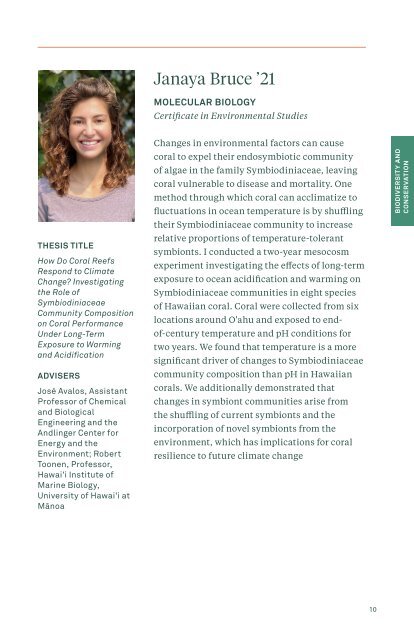Undergraduate Research: An Archive - 2021 Program
You also want an ePaper? Increase the reach of your titles
YUMPU automatically turns print PDFs into web optimized ePapers that Google loves.
Janaya Bruce ’21<br />
MOLECULAR BIOLOGY<br />
Certificate in Environmental Studies<br />
THESIS TITLE<br />
How Do Coral Reefs<br />
Respond to Climate<br />
Change? Investigating<br />
the Role of<br />
Symbiodiniaceae<br />
Community Composition<br />
on Coral Performance<br />
Under Long-Term<br />
Exposure to Warming<br />
and Acidification<br />
ADVISERS<br />
José Avalos, Assistant<br />
Professor of Chemical<br />
and Biological<br />
Engineering and the<br />
<strong>An</strong>dlinger Center for<br />
Energy and the<br />
Environment; Robert<br />
Toonen, Professor,<br />
Hawai'i Institute of<br />
Marine Biology,<br />
University of Hawai'i at<br />
Mānoa<br />
Changes in environmental factors can cause<br />
coral to expel their endosymbiotic community<br />
of algae in the family Symbiodiniaceae, leaving<br />
coral vulnerable to disease and mortality. One<br />
method through which coral can acclimatize to<br />
fluctuations in ocean temperature is by shuffling<br />
their Symbiodiniaceae community to increase<br />
relative proportions of temperature-tolerant<br />
symbionts. I conducted a two-year mesocosm<br />
experiment investigating the effects of long-term<br />
exposure to ocean acidification and warming on<br />
Symbiodiniaceae communities in eight species<br />
of Hawaiian coral. Coral were collected from six<br />
locations around O'ahu and exposed to endof-century<br />
temperature and pH conditions for<br />
two years. We found that temperature is a more<br />
significant driver of changes to Symbiodiniaceae<br />
community composition than pH in Hawaiian<br />
corals. We additionally demonstrated that<br />
changes in symbiont communities arise from<br />
the shuffling of current symbionts and the<br />
incorporation of novel symbionts from the<br />
environment, which has implications for coral<br />
resilience to future climate change<br />
BIODIVERSITY AND<br />
CONSERVATION<br />
10

















